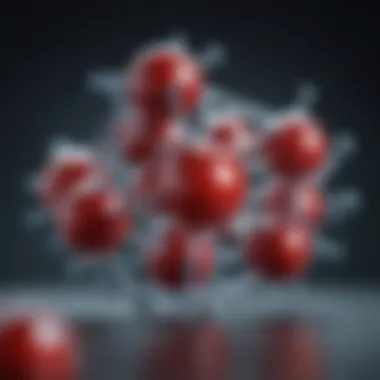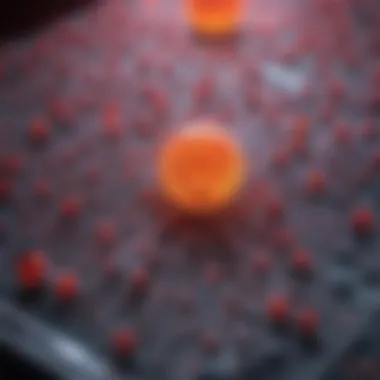Exploring CFSE ThermoFisher: Applications and Innovations


Intro
CellTrace™ CFSE (Carboxyfluorescein diacetate succinimidyl ester) from ThermoFisher Scientific plays a pivotal role in cellular analysis. This dye is crucial for tracking cell proliferation and migration due to its unique fluorescence properties. Researchers increasingly integrate CFSE in various studies, ranging from immunology to cancer research, showcasing its versatility across biological fields. Understanding CFSE's core functionalities, applications, and recent innovations is essential for leveraging its potential in contemporary research.
Key Findings
Summary of the Main Results
CFSE has been established as a powerful tool in fluorescence-based assays. One of its primary capabilities is monitoring cell division, where it is diluted among daughter cells during cytokinesis. This allows researchers to quantitatively assess proliferation through flow cytometry or microscopy techniques. Recent work has highlighted CFSE's effectiveness in not only visualizing live cell behaviors but also in elucidating complex cellular interactions in mixed populations.
Significance of Findings Within the Scientific Community
The introduction of CFSE has led to significant advancements in various research arenas. It has improved the accuracy of cell tracking, making it invaluable for studies on immune responses and tumor biology. Scientists appreciate CFSE for its stability and ease of use, ensuring reproducibility within experiments. The dye's ability to perform in different experimental conditions also underscores its relevance in the scientific community. As research continues to evolve, CFSE's role will likely expand further.
Applications of CFSE in Real-World Scenarios
The myriad applications of CFSE span across numerous domains of biological research:
- Immunology Studies: Understanding T cell activation and proliferation.
- Cancer Research: Assessing tumor growth dynamics and treatment responses.
- Stem Cell Research: Investigating lineage differentiation and cell fate.
- Vaccine Development: Evaluating immune memory and protective responses.
These applications illustrate CFSE's adaptability and relevance in addressing complex biological questions.
Implications of the Research
Potential Impact on Future Research Directions
Ongoing research surrounding CFSE indicates several potential avenues for future exploration. Innovations such as higher surface affinity dyes or multiparameter analysis using CFSE can lead to more profound insights into cellular behavior. Additionally, integrating machine learning with CFSE data may enhance data interpretation capabilities, opening pathways to predictive modeling in biology.
In summary, the developments in CFSE technology offer promising prospects for advancing scientific understanding and application across various research fields.
Intro to CFSE ThermoFisher
The exploration of CellTrace™ CFSE from ThermoFisher is crucial for anyone involved in cellular analysis. CFSE, or carboxyfluorescein succinimidyl ester, is a powerful fluorescent dye used for tracking cell division and proliferation. In this section, we will unpack its significance in biological research and the advantages it offers to scientists looking to analyze cellular behaviors.
Understanding the fundamental principles of CFSE and how it interacts with cells lays the groundwork for appreciating its diverse applications. This dye plays a vital role in various research areas such as immunology, oncology, and regenerative medicine. The ability to quantitatively assess cell division and monitor cellular responses is indispensable in contemporary research practices.
Understanding CFSE
CellTrace CFSE is specifically designed for cellular labeling. Its high stability and low cytotoxicity are paramount for preserving cell integrity during experiments. CFSE operates by covalently binding to cellular proteins, allowing for effective tracking across generations of cell division. As cells divide, the fluorescent signal is diluted but remains detectable, enabling researchers to quantify the rate of division.
Applications involving CFSE have significantly enhanced our understanding of various biological processes. Researchers can now observe how different treatments impact cell cycle progression, ultimately advancing therapeutic strategies and personalized medicine. This versatility is a primary reason CFSE remains a preferred choice within the scientific community.
ThermoFisher Scientific: A Brief Overview
ThermoFisher Scientific is a leader in serving science through its wide range of products and services. Their commitment to advancing scientific discovery includes pioneering technologies such as CFSE. Established over 50 years ago, ThermoFisher has built a reputation for innovation in laboratory equipment and reagents.
Their extensive portfolio not only encompasses cell biology products like CFSE but also includes genomics, proteomics, and analytical chemistry tools. This broad scope contributes to a cohesive understanding of life sciences, making ThermoFisher a pivotal player in facilitating research across multiple domains.
In sum, the introduction to CFSE and its manufacturer sets the context for understanding subsequent applications and methodologies discussed throughout the article. The innovations and advancements stemming from ThermoFisher's products are integral to modern biological research.
Chemical Composition and Properties of CFSE
Understanding the chemical composition and properties of CellTrace™ CFSE is critical for appreciating its function in biological research. This section delves into the unique aspects of CFSE's molecular structure and its fluorescence mechanism, which together underpin its utility in cellular applications. Knowing these elements can significantly enhance the design and interpretation of experiments involving CFSE staining.
Molecular Structure


CFSE, or carboxyfluorescein succinimidyl ester, has a specific molecular structure that is pivotal to its functionality. The molecule includes a fluorescein moiety, which is responsible for its fluorescent properties, and a succinimidyl ester group, which facilitates conjugation to proteins or cellular components. The succinimidyl ester reacts readily with amine groups on proteins, allowing CFSE to stain cells effectively.
The simplicity in its structure allows for efficient penetration into the cell membrane. Once inside, CFSE becomes hydrolyzed to carboxyfluorescein, which remains trapped within the cell due to its inability to cross back through the membrane. This property enables researchers to track cellular division over time. As cells proliferate, the fluorescent signal gets diluted among daughter cells, providing a quantitative measurement of division.
Fluorescence Mechanism
The fluorescence mechanism of CFSE is vital for its applications in cell analysis. Upon excitation by light at a specific wavelength, CFSE emits light at a longer wavelength. This shift is a fundamental aspect of fluorescence that allows for the distinction between stained and unstained cells in flow cytometry or imaging systems.
The intensity of the fluorescence correlates directly with the amount of CFSE retained in the cell. As the cell divides, the fluorescence intensity decreases, offering an accurate measure of cell proliferation. In addition to its utility in measuring division, the fluorescence properties of CFSE can be used in various applications, ranging from immunological studies to kinetic analyses of cell behavior.
"The molecular structure of CFSE plays a crucial role in its effectiveness as a cellular tracking dye."
In summary, the chemical properties and composition of CFSE are integral to its role in cellular studies. Understanding the molecular structure and the fluorescence mechanism enables researchers to design better experiments and interpret results with clarity.
Applications of CFSE in Research
The use of CellTrace™ CFSE from ThermoFisher in scientific research is pivotal for advancing biological knowledge across many disciplines. CFSE offers unique capabilities in cellular analysis, particularly through its ability to stain cells for monitoring various biological processes. This section will highlight the significant applications of CFSE in research, which include insights into cell proliferation, immunology, stem cell dynamics, and cytotoxicity testing. Understanding these applications is essential for researchers aiming to leverage CFSE's strengths in their experiments.
Cell Proliferation Studies
Cell proliferation studies are fundamental in understanding how cells grow and divide. CFSE is particularly valuable in these studies because of its fluorescent properties that allow researchers to track cell divisions over time. When a cell divides, the CFSE dye is distributed equally to daughter cells, resulting in a decrease in fluorescence intensity with each division.
This dilution effect enables researchers to quantify the number of cell divisions that occur. In cancer research, for example, understanding how tumor cells proliferate is crucial for determining how to inhibit their growth. Investigators can use this technique to test new drugs that aim to reduce or halt cancer cell proliferation. This real-time monitoring provides insights that static measurements cannot.
Immunology and Disease Research
In immunology, CFSE serves as a critical tool for exploring immune cell behavior. For example, tracking the proliferation of T cells upon exposure to antigens can shed light on immune responses. This property of CFSE allows for an assessment of how effective a vaccine might be, by measuring the proliferative response of T cells to the vaccine antigens.
Moreover, CFSE is applied in studying various autoimmune diseases where understanding the activation and proliferation of immune cells is necessary for identifying therapeutic targets. Through precise measurements of cell proliferation in response to various stimuli, researchers can understand the intricate dynamics of immune cells, improving treatment approaches for conditions like rheumatoid arthritis or lupus.
Stem Cell Research
In stem cell research, CFSE offers insights into the functionality of stem cells and their differentiative capabilities. Researchers commonly track the fate of stem cells and their progeny to understand lineage and potential therapeutic uses. By labeling stem cells with CFSE, it is possible to follow their proliferation and differentiation in vitro and in vivo.
Furthermore, CFSE can provide critical data on how environmental factors affect stem cell behavior. Knowing how stem cells respond to specific conditions or treatments can help optimize protocols for stem cell therapy—a promising approach in regenerative medicine.
Cytotoxicity and Drug Testing
CFSE is also indispensable in cytotoxicity studies, where it helps to evaluate the effectiveness of new pharmacological agents. By incorporating CFSE staining, researchers can determine how drugs affect cell viability by measuring changes in fluorescence following treatment. This technique allows for a clear comparison of treated versus untreated cells, facilitating the identification of potential cytotoxic effects of therapeutic compounds.
Additionally, CFSE is useful in characterizing the mechanisms of action of drugs. For example, if a drug reduces the proliferation of certain cell types, it can be tested comprehensively using CFSE to elucidate the underlying mechanisms involved. This data is vital for drug development and safety assessments, as researchers can discern not only if a drug works but also how it impacts cellular behavior.
"CFSE staining brings significant clarity to cellular dynamics that static measures fail to provide. It bridges the gap between observation and analysis."
In summary, CFSE serves as a multifaceted tool in various research domains, underpinning essential studies in cell proliferation, immunology, stem cell research, and cytotoxicity testing. Each application showcases the importance of CFSE in enhancing our understanding of cellular mechanisms and therapeutic responses in scientific research.
Methodology Involved in CFSE Staining
The methodology associated with CFSE staining is critical for the accurate analysis of cellular behavior. Understanding this process enhances the overall effectiveness of experiments utilizing CFSE. It brings forward major elements such as preparation of samples, specific staining protocols, and familiarity with flow cytometry techniques. Each of these components is vital to ensure the reliability and reproducibility of research findings.
Sample Preparation
Sample preparation is the foundational step in CFSE staining. Properly prepared samples are essential for optimal staining and subsequent analysis. Researchers must ensure that cells are in a healthy condition prior to labeling. This step usually involves isolating cells from tissues or cultures and following specific protocols to minimize artifactual changes in cellular physiology.
- Cell Viability: It is important to assess cell viability. Dead cells can interfere with CFSE signal detection, leading to inaccurate results. Researchers often use trypan blue or similar dye exclusion methods to achieve this.
- Cell Density: The density of cells can affect the degree of staining. A cell concentration typically around 1-5 million cells per milliliter is recommended for optimal results.
- Washing Steps: After isolation, cells should be washed several times with phosphate-buffered saline (PBS) to remove any remaining contaminants that may interfere with CFSE binding.


Staining Protocols
Staining protocols dictate how CFSE is applied to your sample, defining the efficiency of the staining process. Correct adherence to these protocols is necessary for achieving precise and reproducible data.
- Dilution of CFSE: Typically, CFSE is diluted to a specific concentration in a suitable buffer. The commonly recommended dilution ranges from 2.5 to 10 μM, depending on the particular experiment and cell type.
- Incubation Conditions: Cells are then incubated with CFSE at 37°C for approximately 10-20 minutes. This allows sufficient time for the dye to penetrate the cells effectively.
- Quenching Staining: The reaction can be quenched by adding a large volume of complete culture medium. This action stops the staining reaction, preventing background fluorescence in future analyses.
It is advisable to optimize conditions specific to the cell type or tissue being studied for best results.
Flow Cytometry Techniques
Flow cytometry is an imperative technique for analyzing CFSE-stained cells. This technology allows researchers to measure physical and chemical properties of individual cells. Understanding and utilizing flow cytometry techniques enhance the resolution of data obtained from CFSE staining.
- Compensation Settings: Setting proper compensation is crucial due to the inherent spectral overlap among fluorescence emissions. This requires careful adjustment of the flow cytometer based on specific experimental requirements.
- Data Analysis Software: Post-acquisition, data must be analyzed using software capable of handling complex datasets. Tools like FCS Express and FlowJo are popular, providing capabilities to segment and assess cells based on CFSE fluorescence intensity.
Flow cytometry not only detects the optimal signal-to-noise ratio but also enables comprehensive analysis of cell proliferation, giving insights into cell division dynamics.
In summary, a clear understanding of methodology involved in CFSE staining is vital for successful application in research. By focusing on meticulous sample preparation, adhering to specific staining protocols, and mastering flow cytometry techniques, researchers can maximize the utility of CFSE in biological studies.
Innovations in CFSE Applications
The innovations in CFSE applications signal a remarkable evolution in the field of cellular analysis. As researchers seek more effective ways to study cellular behavior, these innovations serve as pivotal enhancements. Improved techniques elevate the capacity to discern subtle cellular differences, making research more precise. This section will explore the notable advancements in CFSE usage, focusing on novel staining techniques, integration with imaging technologies, and advancements in data analysis.
Novel Techniques in Staining
Recent advancements have introduced novel techniques in CFSE staining, which enhance the original protocols. Traditional methods often faced limitations, such as inconsistent staining or extensive preparation times. New protocols now allow researchers to achieve rapid and consistent results.
These updated techniques often incorporate optimized buffers and advanced dyes that facilitate better cellular labeling without compromising viability. Additionally, innovative methodologies, like multiparametric flow cytometry, have emerged. This allows for simultaneous analysis of multiple markers, increasing the throughput of information obtained from the CFSE staining.
Furthermore, automation has become a significant factor. Automated systems streamline the staining process. This reduces human error while increasing reproducibility. Overall, these innovations contribute greatly to higher accuracy in experimental results, benefiting a wide array of research fields.
Integration with Imaging Technologies
The integration of CFSE staining with advanced imaging technologies marks a significant leap forward. This convergence allows for in-depth examination of cells beyond fluorescence. Techniques such as high-content imaging and laser scanning microscopy create a multidimensional view of cellular processes.
By combining CFSE with imaging technologies, researchers can visualize dynamic cellular behaviors. They are able to analyze live cells in real time, which was not possible with earlier techniques. This integration also improves the ability to track cellular changes over time. As a result, many investigators can monitor cellular responses to stimuli more effectively.
In this light, the fusion of CFSE with advanced imaging systems opens avenues for discovering cellular interactions and elucidating complex biological phenomena.
Advancements in Data Analysis
Data analysis has evolved considerably as a result of technological innovations associated with CFSE applications. Today’s computational tools enable researchers to effectively handle large datasets generated from experiments. Software that utilizes machine learning algorithms processes data more efficiently, leading to quicker and more insightful interpretations.
Moreover, advanced statistical methods now provide more reliable validation of findings. This means researchers can draw robust conclusions from studies involving CFSE without excessive ambiguity.
A notable example is the use of bioinformatics in analyzing flow cytometric data. Such practices help in distinguishing nuances within cell populations that reflect different biological states. This capability significantly enriches the understanding of complex cellular behaviors and might lead to novel therapeutic strategies in future studies.
"Advancements in data analysis are crucial for turning raw experimental data into meaningful biological insights."
Challenges and Limitations of CFSE
The use of CellTrace™ CFSE from ThermoFisher offers significant advancements in cellular analysis, but it also presents various challenges. Understanding these limitations is crucial for researchers. Awareness of potential issues allows for better experimental design and interpretation of data. Addressing the challenges ensures not only the integrity of the results but also the reproducibility of experiments. In biological research, where precision is paramount, these challenges can impact the overall validity of findings.
Technical Challenges in Staining
Staining with CFSE presents multiple technical challenges. One common issue is the optimization of staining concentrations. Overstaining can lead to high background fluorescence, complicating analysis and interpretation of results. Conversely, understaining might not distinctly label the cells, rendering an unreliable output. Proper controls are necessary in every experiment to validate the staining procedure. Researchers should familiarize themselves with the protocol to adjust these parameters effectively. Time and environmental conditions can also affect results. Changes in the maturity of stained cells during analysis can obscure the data. Precise handling and timing are important.


Interpretation of Results
Interpreting results obtained from CFSE staining demands careful consideration. Since CFSE measures cell division by analyzing fluorescence intensity, variations in cell cycle duration can lead to discrepancies in data. Cells that divide slower than expected may appear to have less CFSE staining. This discrepancy can mislead researchers regarding cell proliferation rates. Moreover, when analyzing complex samples, the separation of single-cell data becomes difficult. High background fluorescence or overlapping emission spectra from other dyes can cause interference. For accurate interpretation, researchers often rely on established benchmarks and peer-reviewed protocols.
Potential Artifacts in Experiments
Artifacts can arise during CFSE applications, potentially misleading researchers. Common artifacts include non-specific staining and fluorescent bleed-through. Non-specific staining occurs when the dye attaches to unintended components in the sample. This can result in false positives that misrepresent the cells being studied. Fluorescent bleed-through, meanwhile, occurs when signals from other fluorescent markers overlap with CFSE, complicating data analysis. These artifacts can obscure real biological signals, making it necessary for researchers to apply thorough validation protocols. Employing appropriate controls and techniques such as compensation in flow cytometry can minimize these issues.
Understanding the challenges and limitations of CFSE is integral to enhancing accuracy in cellular analysis and ensuring high-quality research outputs.
Comparative Analysis with Other Staining Methods
The comparative analysis of CFSE with other staining methods is crucial to understand its unique advantages and limitations. This examination not only highlights CFSE's specific capabilities in cellular analysis but also positions it within the broader context of available techniques. In an era where precision and clarity of results are paramount, evaluating various staining methods ensures informed choices for researchers and educators alike.
Advantages of CFSE Over Other Dyes
CFSE, or Carboxyfluorescein Succinimidyl Ester, offers several advantages that make it a favored choice among staining dyes used for tracking cell division and proliferation.
Some of these advantages include:
- Stable Fluorescence: CFSE provides robust fluorescence intensity, which allows for reliable detection even in low-abundance populations.
- Long-Term Labeling: The dye remains effective over extended periods, enabling researchers to monitor long-term cellular processes without frequent re-staining.
- Multiplexing Capability: CFSE can be utilized in combination with other fluorochromes. This allows for simultaneous analysis of multiple parameters in a single sample.
- High Resolution: With fine-resolution capabilities, CFSE enhances data quality, which is essential for precise interpretations of cellular behavior.
These advantages position CFSE favorably against other staining methods, establishing it as a powerful tool in the arsenal of cell biology.
Limitations Compared to Other Techniques
While CFSE has distinctive strengths, it is essential to be aware of its limitations. Understanding these aspects is vital when selecting a staining method for specific experimental designs.
Some noteworthy limitations include:
- Photobleaching Sensitivity: CFSE is liable to photobleaching, meaning fluorescence can diminish when exposed to light for excessive durations. This may affect results in long experiments.
- Background Signal: In some cases, CFSE can produce background fluorescence, complicating data analysis and interpretation.
- Cellular Toxicity: Prolonged exposure or high concentrations may lead to cytotoxic effects, thus impacting viable cell populations.
- Limited Post-Staining Applications: Unlike some newer methods that allow for subsequent applications like genomic analysis, CFSE has a more restricted scope after initial staining.
A comprehensive understanding of these limitations is essential for responsible utilization and application in biological studies.
Future Perspectives on CFSE Research
The future of CFSE research is promising, especially with the rapid advances in technology and the increasing demand for refined cellular analysis. CFSE, or Carboxyfluorescein succinimidyl ester, is an essential tool in modern biology, notably in immunology, drug development, and cancer research. This section highlights key areas where CFSE can evolve and contribute to various fields.
Emerging Trends in Cellular Analysis
Emerging trends in cellular analysis focus on the integration of CFSE with cutting-edge technologies. For instance, the combination of CFSE with multiplex staining methods can enhance the ability to track numerous cell populations simultaneously. As high-throughput screening becomes more prevalent, CFSE's role will adapt to accommodate this need.
- Key trends include:
- Single-Cell Sequencing: This allows for detailed gene expression analysis, which can be paired with CFSE for in-depth cellular tracking.
- Real-Time Imaging: Integrating CFSE with advanced imaging systems provides live feedback during experiments, crucial for observing dynamic cellular behaviors.
- Artificial Intelligence: AI-driven analysis can improve data interpretation from CFSE experiments, making insights more accessible and reliable.
Potential New Applications in Biotechnology
Biotechnology continues to be a fertile domain for CFSE applications. As research expands, new possibilities for utilizing CFSE emerge, including:
- Gene Therapy: CFSE could be used to monitor the proliferation and differentiation of genetically modified cells, giving insights into the effectiveness of therapies.
- Personalized Medicine: With an increasing focus on individualized treatment plans, CFSE can assist in identifying patient-specific responses to drugs based on their cellular profiles.
- Vaccine Development: Tracking immune response through CFSE can streamline the process of vaccine testing and optimization, particularly in identifying effective formulations faster than traditional methods.
"As science pushes the boundaries of existing methodologies, CFSE stands to play a critical role in enhancing our understanding of complex biological systems."
Finale
The conclusion serves as a vital component of this article by synthesizing the key insights on CFSE from ThermoFisher. It underscores the significance of the insights gained while exploring this innovative tool for biological research. The essence of using CFSE lies in its application for tracking cell division, which is crucial in multiple fields such as immunology and stem cell research.
Summary of Key Points
In summary, this article reflected several significant aspects of CFSE:
- Versatile Applications: CFSE is extensively used in various domains including cell proliferation studies and immunology. These applications have benefitted from the unique properties of CFSE, allowing researchers to gain deeper insights into cellular behaviors and interactions.
- Methodological Rigor: The methodologies involving CFSE staining and analysis through flow cytometry have been detailed. These protocols ensure reproducibility and accuracy in experimental outcomes, which is paramount for scientific studies.
- Emerging Innovations: Innovations in CFSE staining techniques and their integration with imaging technologies highlight an evolutionary path in cellular analysis. Understanding these advancements provides researchers with new avenues to explore.
- Challenges Faced: Despite its advantages, challenges such as technical issues during staining, result interpretation, and potential artifacts must be considered to ensure credible research findings.
- Future Directions: Lastly, the article discussed the bright future of CFSE research, particularly in biotechnology applications. This indicates a promising horizon where CFSE can further contribute to advancements in scientific knowledge, especially in cellular analysis.
Each of these points reinforces the importance of CFSE within various research contexts and its impact on advancing scientific inquiry. The integration of CFSE into biological studies not only informs current practices but also shapes future research strategies. Understanding these dimensions is essential for students, researchers, educators, and professionals committed to exploring the depths of biological research.







